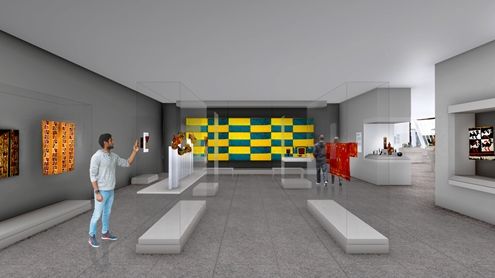Rendering of Arts of the Ancient Americas Galleries, The Metropolitan Museum of Art. Image by WHY Architecture
Opening Date: May 31, 2025
The complete renovation of the wing, which encompasses over 40,000 square feet of gallery space on the Museum’s south side, was designed by Kulapat Yantrasast of WHY Architecture
The Metropolitan Museum of Art announced that it will reopen the Michael C. Rockefeller Wing on May 31, 2025, following the completion of a major renovation. The wing includes the collections of the Arts of Africa, the Ancient Americas, and Oceania, and, when complete, will feature over 1,800 works spanning five continents and hundreds of cultures. These three major world traditions will stand as independent entities in a wing that is in dialogue with neighboring gallery spaces. The galleries have been closed to the public and under renovation since 2021.
Designed by WHY Architecture in collaboration with Beyer, Blinder, Belle Architects LLP, and with The Met’s Design Department, the reimagined galleries have been designed to transform the visitor experience and incorporate innovative technologies that will allow The Met to display objects in new ways. In galleries dedicated to each of the distinct collection areas, design elements reference and pay homage to the architectural vernaculars of each region.
The reinstallation of all three collection areas—Arts of Africa, the Ancient Americas, and Oceania—will also reflect new scholarship, undertaken in collaboration with international experts and researchers. Digital features and new wall text will allow for deeper contextualization of objects. Highlights of the collections that are well known to long-time visitors to The Met will be showcased in innovative ways with a completely new gallery design, which will also incorporate filtered daylight through a custom-designed, state-of-the-art sloped glass wall on the south facade, adjacent to Central Park. Additionally, across each collection there will be objects on view for the first time, including major new acquisitions of historic and contemporary art in the Arts of Africa galleries; a gallery dedicated to light-sensitive ancient Andean textiles, which will be the first of its kind in the United States; and several new commissions for the Oceania galleries by Indigenous artists and a range of new digital features that will present contemporary perspectives.
“The complete renovation of the Michael C. Rockefeller Wing reflects The Met’s profound commitment to—and deep expertise—in caring for and expanding understandings of the works in the Museum’s collection. Together with our collaborative and community-based approach to curating these collections, the transformation of these galleries allows us to further advance the appreciation and contextualization of many of the world’s most significant cultures,” said Max Hollein, The Met’s Marina Kellen French Director and Chief Executive Officer. “When the wing first opened in 1982, it brought a much broader perspective on global art history to The Met, and this thoughtful and innovative reimagining reflects our ambition to continually expand and even complexifying narratives. We’re deeply grateful to the many artists, scholars, community leaders and cultural figures who are partnering with us on this essential and ongoing work, and we look forward to unveiling these stunning galleries to visitors across New York City and the world this spring.”
Kulapat Yantrasast, Founder and Creative Director of WHY Architecture, commented: “The Michael C. Rockefeller Wing affirms WHY’s belief that museums are true sites of empathy. Spaces where visitors from many different places can encounter and appreciate the artworks from other cultures around the world. Through our design with The Met, we hope to highlight the diversity and distinction within these rich collections while providing a welcoming and memorable sense of place. Natural light and visual connections to Central Park are essential to the reimagined wing, and moments of discovery are so crucial when we design art spaces. We hope that visitors remember what they experience and where that happens.”
Alisa LaGamma, Ceil and Michael E. Pulitzer Curator of African Art and Curator in Charge of The Michael C. Rockefeller Wing, said: “The primary goal of this considerable institutional project is to deepen appreciation for the greatness of the art displayed within. While the creation of the wing asserted the place of the arts of sub-Saharan Africa, the Ancient Americas, and Oceania in the world’s leading museum, the edition you will soon experience underscores their autonomy from one another and foregrounds the artists responsible for those achievements. The new galleries devoted to three major collections presented in the Michael C. Rockefeller Wing allow us to reintroduce them with to the public enriched with a wealth of contextual detail. Those layers of information range from artist bios to interviews with experts in the region that relate the works presented to specific historical sites in the form of audioguide commentary and documentary films produced as an integral part of the experience.”
Jhaelen Hernandez-Eli, Vice President of Capital Projects at The Met, commented: “Our buildings are works of art themselves, mediating the relationship between the environment, our collections, and the communities we host. The redesign of the wing addresses the most critical issues of our time, from carbon footprint reduction to the emphasis on local materials and artisanship. The project manifests the collective work and shared values of our architects and engineers—WHY Architecture, Beyer, Blinder, Belle Architects LLP, Kohler Ronan, Thornton Tomasetti and Arup—as well as our local trades shepherded by AECOM Tishman. Together, we prioritized job creation and workforce training, reuse of materials, and the reduction of energy consumption while ensuring that the resulting architecture supports our collection and inspires our public.”
About the Michael C. Rockefeller Wing
The Met’s Michael C. Rockefeller Wing includes the three distinct collections—the Arts of Africa; the Ancient Americas; and Oceania—displaying them as discrete elements in an overarching wing that is in dialogue with the Museum’s collection as a whole.
During the 1950s and 1960s, the American statesman and philanthropist Nelson Aldrich Rockefeller assembled a fine-arts survey of non-Western art traditions that included the ancient Americas as well as areas of the world not represented in the Museum’s collection, notably African and Oceanic art. In 1969, it was announced that Rockefeller’s collection would be transferred to The Met as a new department and wing. Opened to the public in 1982, the addition was named after Nelson Rockefeller’s son, Michael C. Rockefeller, who was greatly inspired by the cultures and art of the Pacific and pursued new avenues of inquiry into artistic practice during his travels there. Among the wing’s signature works are the striking Asmat sculptures he researched and collected in southwest New Guinea.
Arts of Africa Galleries
Like this:
Like Loading…
Related
Source link : https://thecitylife.org/2024/10/07/the-met-to-reopen-the-newly-reimagined-galleries-dedicated-to-the-arts-of-africa-the-ancient-americas-and-oceania/
Author :
Publish date : 2024-10-07 16:10:40
Copyright for syndicated content belongs to the linked Source.


 100vw, 495px”/>Rendering of Arts of Africa Galleries, The Metropolitan Museum of Art. Image by WHY Architecture</p><p>The reenvisioned installation will reintroduce visitors to The Met’s collection of sub-Saharan African art through a selection of some 500 works organized to survey major artistic movements and living traditions from across the subcontinent. The new galleries will present original creations spanning from the Middle Ages to the present, including artworks such as a 12th century CE fired clay figure shaped in Mali’s Inner Niger Delta to the fiber creation Bleu no. 1 (2014) by Abdoulaye Konaté (born 1953, Diré, Mali), a critically acclaimed innovator based in Bamako, Mali. One-third of the works, which are new acquisitions given by donors to celebrate The Met’s capital project, will be on display at The Met for the first time.</p><p>The reconceived galleries anchor this extraordinary collection within regional architectural vernaculars and pay tribute to Africa’s distinctive cultural landmarks—such as a soaring ceiling spanned by a succession of horizontal baffles that suggest ribbing to pay homage to one of Africa’s most celebrated structures: the Great Mosque of Jenne in Mali—while highlighting connections to other major world traditions. The new galleries, which are immediately adjacent to those of Greek and Roman Art and European Sculpture and Decorative Arts, will underscore Africa’s ancient visual traditions and its historical connections with Europe going back to the Renaissance. </p><p>The reinstallation is grounded in contemporary research and exchanges with a network of international experts based in the United States and across sub-Saharan Africa. A major component of the expanded contextualization is a digital initiative that introduces Africa’s distinctive cultural landmarks in a series of original films produced with Ethiopian-American filmmaker Sosena Solomon that will be displayed in the gallery as well as online and that was undertaken in partnership with World Monuments Fund (WMF).</p><p>For more information about the Arts of Africa galleries. </p><p>Arts of the Ancient Americas</p><p>The reinstallation is organized around some 700 works selected to foreground the artistic legacy of Indigenous artists from across North, Central, and South America and the Caribbean prior to 1600 CE. This extraordinary collection will be reintroduced for a new generation of visitors while reflecting contemporary scholarship and research and providing greater illumination of the ancestral arts of the Americas. The new galleries will include monumental stone sculptures and exquisite metalwork and will also include refined ceramic vessels; shimmering regalia of gold, shell, and semiprecious stone; and delicate sculptures of wood.</p><p>The new galleries for the Arts of the Ancient Americas are across from the Modern and Contemporary Art galleries and adjacent to those dedicated to the arts of the Oceania. Drawing inspiration from ancient American architectural traditions, the design incorporates stone platforms that echo the layout of landmarks from Mesoamerica and the Andean region, from the rectilinear plazas of Central Mexico to the U-shaped, enfolding arms of sacred architecture of Peru’s North Coast. A highlight will be a new gallery devoted to ancient American textiles and featherwork, which will frame a 3,000-year history of achievements in the fiber arts. </p><p>The new installation is the result of a close collaboration with colleagues across Latin America over the past eight years. The renovated galleries will reflect recent advances in scholarship, incorporating knowledge about artists, their materials, their techniques, and their social roles and newly revealed relationships between regions. They will also expand the scope to consider Indigenous traditions in the Viceregal (Colonial) period. The galleries also benefit from new perspectives on indigenous concepts of the natural world as well as nuanced perceptions of gender roles. Indigenous texts—ancient, historical, and modern—have informed the curatorial narrative, enriching the interpretation and appreciation of the works in the collection.</p><p>Joanne Pillsbury, the Andrall E. Pearson Curator of the Arts of the Ancient Americas, said, “Since the Museum’s founding, the presence of these works at The Met has reflected shifting sensibilities about the place of ancient American art in a global history of art. Over the last 30 years, we’ve seen a revolution in our understanding of the Inca, the Classic Maya, and the other great cultures that thrived in Latin America before the 16th century, including the identification of specific, named artists. It has been exciting to work with scholars from across the Americas to reconceive the galleries in light of this new knowledge.” </p><p>For more information about the Arts of the Ancient Americas galleries.</p><p>Arts of Oceania Galleries</p><p><img data-recalc-dims=)



